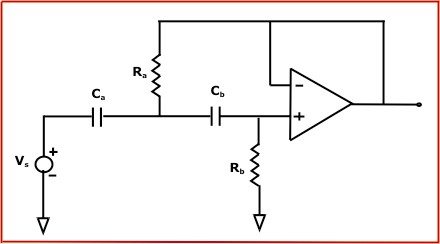| Sallen-Key Butterworth High Pass Filter Calculator |
|
|
|
|
| Enter value and click on calculate. Result will be displayed.
|

| Ra = Filter Resistor
Rb = Filter Resistor
Ca = Filter Capacitor
Cb = Filter Capacitor
(Ca = Cb)
|


|
|
The Sallen-Key type filter was introduced by R.P. Sallen and
E. L. Key of MIT Lincoln
Laboratory in 1955.
|
The circuit produces a
2-pole highpass response using two resistors, two capacitors and
a unity-gain buffer amplifier. This filter topology is also known as a voltage controlled voltage
source (VCVS) filter.
The Sallen-Key filter is a simple active filter based on op-amps stages, which is ideal for
filtering audio frequencies.
It is one of the most widely used filter topologies. One reason for its popularity is that
this configuration shows the least dependence of filter performance on the performance of
the op-amp. Another advantage of this configuration is that the ratio of the largest resistor value to
the smallest resistor value and the ratio of largest capacitor value to the smallest
capacitor value are low, which is good for manufacturability.
A serious drawback is that the filter is not easily tuned.
A High pass filter is a filter that passes high frequencies, but attenuates
frequencies lower than the cutoff frequency.
|